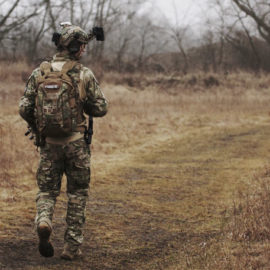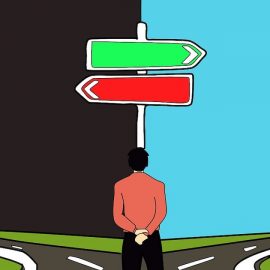

This article is an excerpt from the Shortform book guide to "Great by Choice" by Jim Collins and Morten T. Hansen. Shortform has the world's best summaries and analyses of books you should be reading.
Like this article? Sign up for a free trial here .
What is productive paranoia? Can being paranoid about the future of your business do you any good?
There’s no telling what kind of unfortunate event is going to happen, but given an unstable, constantly changing world, disruptions are inevitable. When disaster strikes, there won’t be time to think—you need to act fast. This is where productive paranoia— comes in.
Here is how productive paranoia can shield your business from sudden disruptions.
What Is Productive Paranoia?
The 20 Mile March (fanatic discipline) and firing bullets before cannonballs (empirical creativity) might be enough to achieve success when conditions are stable. But the world is plagued by instability; you never know what’s going to happen next, so you need more than just discipline and creativity. This is where productive paranoia comes in.
When disaster strikes, there are only three outcomes for an enterprise: They pull ahead, they lag behind, or they hit what the authors call the “Death Line” (game over for the enterprise). 10X companies pulled ahead by going by a credo: If you stay ready, you don’t have to get ready. They knew that calamities were impossible to predict but that they could and would happen, so it was best to be prepared for every eventuality. Driven by productive paranoia, they constantly asked “What if?” and found ways to mitigate nightmare scenarios.
Putting Productive Paranoia into Practice
10X companies used productive paranoia to:
1. Set up buffers. An unforeseen event can drain an enterprise’s resources, crippling or killing the company. The 10X cases protected themselves by building cash reserves, having three to 10 times the ratio of cash to assets compared to other companies. In a perfect world, having so much idle cash may not be a good use of a company’s resources—but the reality is, it’s not a perfect world. Disruptive events are inevitable, and cash on hand can serve as a shock absorber, increasing a company’s chances of survival.
- Example: When the terrorist attacks of 9/11 happened, Southwest was uniquely positioned. Not only did they have crisis and contingency plans in place, but they also had plenty of cash on hand—$1 billion to be exact! While competitors cut back on operations right after 9/11, it was business as usual for Southwest. They operated all their regular flights, retained all their employees, and remained profitable through 2001. They were the only major airline to make a profit in 2002.
2. Limit and manage risk. 10X companies took risks, but they took fewer risks than the comparison companies. They avoided risks that could cripple or kill them (send them to the Death Line), risks that didn’t come with a big enough payoff, and risks that would make them vulnerable to events they couldn’t control. When a time-based risk came into play, the 10X companies didn’t make panicked decisions. Instead, they assessed the situation and made decisive moves based on the time frame. They took their time when they could but moved fast when they had to.
- Example: In 1989, Stryker noted in their annual report that rising healthcare costs in the US could, paradoxically, lead to lower prices on medical products, which would be bad for their business. Stryker, a properly paranoid 10X company, prepared for this what-if scenario by squirreling away cash through the 1990s. By the late 1990s, rising healthcare costs led to the emergence of hospital buying groups on an acquisition spree. Companies either had to scale up or be shut out. With their cash reserves from years of preparation, Stryker was perfectly poised to acquire Howmedica. After the purchase, Stryker became one of the biggest players in the industry.
3. Take both a macro and micro view of the landscape. As 10Xers go on their 20 Mile March, they don’t just look at the road right in front of them, tracking every step. They also look around them to see if there are any threats. When they sense danger, they take a step back and survey the landscape (“zoom out”). They assess how much time they have before the threat is within striking distance, then they adjust their plans and focus on the details of mitigating the threat, aiming for flawless execution (“zoom in”).
- Example: In 1979, Motorola posed a big problem for Intel. Motorola was racking up design win after design win and, if they continued on this path, they would become the industry standard, rendering Intel obsolete. Recognizing the urgency, Intel quickly formed a special team to address the looming threat. Within three days, the team had looked at the big picture—analyzing what Motorola was doing right and what Intel was doing wrong, and deciding on the best course of action—before turning their attention to the details. They formulated a comprehensive plan called Operation CRUSH and, within the week, enlisted a hundred team members to execute the plan. Intel proceeded to rack up 2,000 design wins in a year, crushing the Motorola threat.
Example
In 1996, David Breashears and his film crew were at Camp III on Mt. Everest, preparing to climb to the summit. As they got ready for their ascent, Breashears spotted dozens of climbers, led by guides Rob Hall and Scott Fischer, making their way up from Camp II. Breashears assessed the situation and went through his list of nightmare scenarios: anchors dislodging, an unexpected storm, less experienced climbers getting in the way, and so on. He concluded that an overcrowded summit posed too many risks, and he thus decided to abandon their summit bid for the time being. It was a luxury his team could afford, given his productive paranoia:
- He had built buffers by stocking up on enough oxygen canisters to fuel more than one summit bid and enough supplies to last them three more weeks.
- He limited risk, assessing how their risk profile changed with the addition of dozens of other climbers. He decided to avoid a situation that could put them in peril.
- He looked at the big picture then adjusted his plans accordingly. Given that the presence of other climbers increased their risk and that his team had the capacity to make another bid, he made the decision to make their way down and try another day.
In contrast, Hall and Fischer only had enough oxygen for one summit bid, so they had no choice but to keep going. They ended up getting caught in an unexpected storm and dying on Everest. Breashears and his team had enough oxygen canisters to help the rescue team in their efforts, plus enough left over for their own ascent. They successfully reached the summit a couple of weeks later.

———End of Preview———
Like what you just read? Read the rest of the world's best book summary and analysis of Jim Collins and Morten T. Hansen's "Great by Choice" at Shortform .
Here's what you'll find in our full Great by Choice summary :
- How you can make the choice to be great, no luck needed
- Why certain assumptions about great leaders are actually myths
- How some companies are 10X more successful than their competitors






